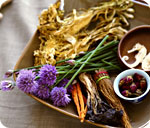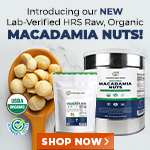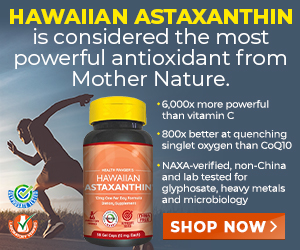
The Side-Effect Challenge: Whole Plant Medicines Vs. Drug Counterparts
Tuesday, February 12, 2008 by: Kal Sellers
Tags: botanical medicine, health news, Natural News
- Newly released JFK files reveal Pentagon's role in creating Lyme disease and covid in the same lab
- Dr. Suzanne Humphries makes bombshell appearance on Joe Rogan podcast, exposing vaccine industry deception back to POLIOMYELITIS
- L.A.'s rebuilding nightmare: Only 4 permits issued after fire destroys 6,000 homes
- Discovery of vast underground city beneath Giza pyramids challenges human history
- Black cumin seed oil emerges as a powerful ally against breast cancer and chronic inflammation
- PROCESSED TABLE SALT in foods found to fuel depression
- Here are TEN all-natural ways to protect your garden without using harmful chemicals
- Ginseng's hidden anti-aging power: How compound K is rewriting the rules of skincare
- “Independent” anti-Russia outlet MEDUZA faces COLLAPSE as US funding dries up
- Catastrophic 7.7 earthquake devastates Myanmar and Thailand; death toll could reach 100,000
- The hidden battle in your glass: How A1 and A2 milk could shape your health
- AI breakthrough slashes celiac disease diagnosis time from months to minutes
- CDC finally halts $11 billion COVID funding scam as health officials admit the ‘pandemic’ was a fraud
- BPA: The hidden hormone disruptor sabotaging your health - and how to fight back
- Sugar-free deception: Artificial sweeteners hijack hunger signals, fuel obesity epidemic, study warns
- Europe braces for WAR as EU urges citizens to STOCKPILE FOOD, in latest provocations with Russia
- “Endgame: The Hidden Agenda 21” unveils a world of conspiracy and control
- Putin vows to 'finish off' Ukraine, accuses West of prolonging the war
- Newly released JFK files reveal Pentagon's role in creating Lyme disease and covid in the same lab
- Analysis: The coming economic collapse, a mass uprising and Trump's three secret weapons to halt the growing revolt
- Festive flavors: The sweet history, nutritional profile and health benefits of pecan pie
- Elon Musk: Aliens could be here on Earth RIGHT NOW
- Trump reverses course on Gaza plan, says “nobody is expelling Palestinians”
- Big Pharma's $8 Billion bribery scheme exposed: how doctors are pushed to prescribe junk science, not heal
- Boys are back in town: Trump’s patriotic alpha crew takes the wheel while toxic females ride in the backseat
- Reclaim your health: How midlife exercise reverses years of inactivity
- A lack of integrity in Academia: Harvard professor found GUILTY of fraudulent research to promote CRT theory
- Survival 101: Effective EMF blocking techniques
- EPA advisor admits the agency is funneling billions to climate groups ahead of Trump’s return to White House
- Dr. Mike Yeadon releases 15-minute testimony - WATCH - about genocidal intent of COVID “vaccines”
- 5 Simple steps to boost your brainpower: How to strengthen executive function in a distracted world
- Florida takes a stand: DeSantis proposes permanent ban on mRNA vaccine mandates
- Sugarcane extract superior to cholesterol-lowering drugs?
- Mike Adams Sermon 66: God will DESTROY ISRAEL for its wickedness
- Pilots report mysterious lights 'moving at extreme speeds' across Oregon skies
- Space war brewing? Russia threatens to destroy Starlink satellites
- EPA advisor admits the agency is funneling billions to climate groups ahead of Trump’s return to White House
- California's social media censorship law struck down: A victory for free speech or a threat to online safety?
- The Health Ranger releases “Vaccine Zombie” song and music video, using AI-animated zombies for the music video
- Dr. Mike Yeadon releases 15-minute testimony - WATCH - about genocidal intent of COVID “vaccines”
- The pandemic as a tool for INDOCTRINATION: Understanding “The Indoctrinated Brain” by Dr. Michael Nehls
- Newly released JFK files reveal Pentagon's role in creating Lyme disease and covid in the same lab
- Florida takes a stand: DeSantis proposes permanent ban on mRNA vaccine mandates
- Mike Adams releases country western hit single: Goin’ Back in Time is Comin’ Home
- Mike Adams releases music poetry sensation: A Child of God
- “Why we influenced the 2020 elections”: Facebook files reveal the coordinated effort to bury the Hunter Biden laptop story
- Unpacking the Lies That We’ve Been Fed – new song and music video released by Mike Adams, the Health Ranger
- RFK Jr. clears key hurdle: Sen. Susan Collins backs controversial HHS nominee, signaling a new era for health policy
- Mike Adams releases new song and music video: Nothing More Disgusting Than a Globalist
- Michigan sheriff announces criminal investigation into 2020 election crimes, Dominion Voting Systems
- Israeli soldiers accused of even more torture and abuse in the West Bank
- Migrants are taking advantage of recent hurricanes to scam residents and loot their homes
- House Intelligence Committee calls for the ARREST and PROSECUTION of Dr. Anthony Fauci
- Rep. Nancy Mace introduces bill to ban biological males from female facilities on federal property
- Red Cross issues warning to stop blood plasma donations from vaccinated people
- Scientists confirm: GENIUS brain function can be spontaneously unleashed in humans without any apparent cause
- EPA advisor admits the agency is funneling billions to climate groups ahead of Trump’s return to White House
- HYSSOP: What research reveals about the health benefits of this ancient holy herb
- Two containers with completed ballots fall out of truck in Florida
- Fully vaccinated about to see “tsunami” of illness and death, warns virologist
- Global leaders unite to clamp down on “misinformation” with UN-backed Cascais Declaration
- BREAKING: 2025 NDAA authorizes mandatory military draft of WOMEN across America… as Pentagon pursues global NUCLEAR war with both Russia and China at the same time
- Michael Yon warns of a ZIONIST TAKEOVER in Trump’s second administration
- BOMBSHELL: DNA testing kits are a SCAM to develop ethnic-specific bioweapons
- Ozempic and Wegovy weight loss drugs are injectable LIZARD VENOM PEPTIDES that may unleash a devastating wave of organ failure… side effects align with symptoms of SNAKE BITES
- Israeli soldiers accused of even more torture and abuse in the West Bank
- These 13 countries just signed an agreement to engineer a global FAMINE by destroying food supply
- NASA admits that climate change occurs because of changes in Earth’s solar orbit, and NOT because of SUVs and fossil fuels
- RFK Jr. clears key hurdle: Sen. Susan Collins backs controversial HHS nominee, signaling a new era for health policy
- Sermon 30: How Jesus reveals Caesar’s FAKE CURRENCY and FALSE AUTHORITY
- Coriander seeds: Ancient medicine backed by modern science
- Arizona officials claim Maricopa County needs 10-13 days to tabulate results of the election
It really only lasted as a wonder drug for malaria for about 50 years. Malaria became quinine-resistant and quinine may not work at all today. The malaria germ adapted to quinine.
Today, it is more likely that you will be prescribed quinine if you have leg cramps. If you get malaria, they will probably look at other drug options.
The interesting thing about this is that Peruvian Bark works as good today as it did 1000 years ago. There are no strains of malaria resistant to Peruvian Bark, only to the isolated quinine.
In addition to this apparent disadvantage of the stronger isolated drug, there are no known side-effects of Peruvian Bark.
According to (www.Drugs.com) , quinine can cause life-threatening side-effects, including: uneven heart rhythm, weak pulse, fainting or collapse, fever, confusion, weakness, pale or yellowed skin, dark colored urine, unusual muscle weakness, purple spots under the skin, urinating less than usual or not at all, severe blistering, peeling, rashes, sore throat, fever, severe nausea, vomiting, stomach pain, diarrhea or hearing and vision problems.
You are likely to be warned about the dangers of both drugs and herbs by a medical profession that is trained to believe in atomism. In order to understand the following discussion, we need to define that word and its opposite.
Atomism is the idea that the body can be reduced to its parts and manipulated. This is built on the idea that any action upon the body must be the action of an isolated chemical.
The opposite of this is vitalism. Vitalism is the concept that the body is a synergistic intelligence that learns and has learned the art of interacting with intelligent nature in the most beneficial way that is always more than the sum of the parts (or the sum of actions of isolated chemicals).
Vitalists believe that there is an enormous difference between manipulating the body using isolated chemicals (drugs) and using whole plant foods that are also intelligent entities with all the complexities of life.
Underlining the theory of vitalism is the belief that the intelligent human body has the capacity to recognize and intelligently use the symbiotic gifts of nature. Since humans and plants exist as symbiotic opposites, plants are used by humans with as much physiological intelligence as the modern-day human possesses. Therefore, atomistic medicine (which is western medicine) tends to disbelieve the potential of herbs and exaggerate the dangers of herbs.
Your doctor might tell you to never risk Lobelia inflata (discussed later in more detail), for example, but might tell you to use baby Aspirin or Tylenol — both thousands of times more dangerous than Lobelia.
Some Statistical Evidence of the Harmfulness of Drugs
I was unable to come to any ballpark figure on how many deaths there are each year due to drugs and medicine. Instead, what I came up with is more like a range of estimates.
The most conservative figures I found varied close to 30,000 deaths per year due to unwanted side-effects from medications that are correctly prescribed and taken. I found estimates for the same thing at 100,000 and upwards of 150,000.
The Stanford Daily Journal reported that about 125,000 deaths occur per year due to people taking prescription drugs incorrectly.
Total unexpected deaths from the western medical profession in this country (USA) was estimated as high as 800,000 per year (this would include all malpractice, iatrogenic disease, surgery and anesthesia problems, drug overdose, drug misuse and abuse and drug side-effects).
It is possible that part of the problem with researching something like this is that it often goes unreported. The lower estimates were specifically talking about reported incidents and may have been talking about only a certain category of drugs (non-steroidal anti-inflammatory drugs, for example). The upper end figures might be taking into account estimates from small groups that have been studied to try to catch deaths that would normally not be reported.
While my research into the matter certainly did not reveal a very clear picture of how many people were really dying due to drugs, it did reveal enough to make the point, which is that herbs are far, far safer on their worst day.
Now let us look at herbs. The very worst year for herbs came during the rampant abuse of Ma Huang by those trying to lose weight with it (this is not one of its clinical actions when used by responsible herbalists).
They were doing two really extreme things: first, they combined it with caffeine sources; second, they made standardized extracts that were standardized only to ephedrine (the strongest alkaloid) mixed in with questionable quality herbs (making something more like a drug than an herb).
Then this was taken in large doses by people who were desperate. I am not blaming them for being desperate, but I am saying this is an extremely unwise behavior. The results of that behavior with a drug would have been devastating (and were devastating if you remember the publicity about Fen-Phen).
What were the results of that abuse that year? An estimated 50 deaths. 50! That is about 1/1,000th, at best estimate, of the deaths due to drugs.
On average, herbs kill a grand total of 5-6 people per year and herbs get abused all the time. People use herbs in a crazy, out of balance way without even consulting a qualified herbalist and we still get 5-6 people per year.
There are a few more medical conditions blamed on herbs but believe me when I tell you that the most dangerous herb still in use is far safer than the safest over-the-counter drug.
Actual Side-Effects of Herbs Examined
So let us take a real look at the actual side-effects and legitimate dangers of herbs that you do have to watch out for and know about in order to get the best and safest possible results.
By far the most common complaint and recorded side-effect of taking herbs is gastrointestinal. This is because herbs frequently cause the liver to dump bile (something herbalists are happy about) or stimulate peristalsis (which they are also happy about) or contain strong bitter elements that stimulate a surge of digestive juices (again, happy!).
This cocktail of actions is beneficial to the digestion and overall health of the body, but it can lead to things like nausea, diarrhea, gas, indigestion or other similar complaints. This is particularly true when herbs are just started.
Then there are herbs that are irritant. This is probably second in line to gastrointestinal complaints. This is partly because a slight irritation is part of how herbs operate. Let's take the blood cleansing herb: Red Clover Blossoms.
Red Clover contains coumaric acid. This acid functions to purify the mucus membranes, clean the congested mucus off of them, get them producing healthy mucus and supplied with adequate blood (which means better immune response) all by irritating the mucus membranes.
The irritation can be uncomfortable, but most herbalists would tell you that the discomfort is a healing "crisis" and that it is desirable. The terminology might need some work, but the action usually is beneficial and almost never harmful.
Poke root is used for a similar ability that it has to irritate the lymphatic ducts and nodes. It causes them to activate and eliminate wastes in places you might never otherwise reach, even on a good cleanse.
One of the ways that herbalists have mediated the strong action of herbs like poke root, is by putting them in a formula that includes some herbs that create protective barriers in the body. Some examples of barrier-producing herbs are licorice, slippery elm, calendula and marshmallow.
This is particularly important when using something that is a kidney irritant like juniper berries or chaparral. These herbs are not really harmful by themselves, and yet it is customary for them to be combined with other herbs that will help ease or change the irritating action. Irritating action of juniper berries, for example, can be eased with marshmallow or it can be changed with ginger, or (more frequently) both.
Then there are some herbs that are supposedly "dangerous" (we are told), because they have the potential to hurt you. Many of these are not harmful at all in the way they are usually used.
For example, Lobelia is safe, even by itself by any standards I know, and yet when the primary alkaloid (lobeline) is isolated and injected hypodermically into rats, it can kill them.
Of course, we are back to the quinine discussion and no responsible herbalist is going to inject an herbal isolate into the blood. Incidentally, when the above study was done the volume needed to kill the rats would have been about 4 pounds of lobelia per 150 lb adult human. This would have to then be injected hypodermically - not very likely.
Comfrey is another story we hear about periodically. Comfrey contains what are called pyrrolizidine alkaloids. These alkaloids are known to cause liver cancer when isolated and fed to study animals. They also have the potential to cause veno-occlusive disease. The reality in the whole plant, however, is quite different.
While comfrey root contains enough of the pyrrolizidine alkaloids to cause liver failure in a very rare, select few, the leaf (which is what gets used about 99.9% of the time) really does not. The adult leaves contain only trace amounts of the pyrrolizidine alkaloids and in volumes usually used, this is unrealistic to label as a danger.
Certainly none of the above herbs are dangerous enough to really get compared to any known over-the-counter drug.
In Dr. Duke's book, The Green Pharmacy Herbal Handbook, he discusses herb dangers and rates them aggressively. He makes every effort to err on the side of caution and yet even he says that several commonly used culinary herbs and foods are arguably as dangerous as any herb on the market. He notes black pepper, basil, artichokes, chamomile, Echinacea, peppermint, spearmint and green and black tea.
The reality is obvious to anyone who is paying attention: our bodies have adapted or have been created for the remedies nature offers. That is why, with all the abuse and almost criminal carelessness with which herbs are used by many people, there are still only about 5-6 deaths per year due to herbs.
Then we have the issue of herb-drug interactions. Now this is a legitimate concern for one of two reasons. Either the herb will detoxify (make less potent) the drug, as happens with some drugs and St. John's Wort, or the herb will potentiate (make more potent) the drug, as happens with grapefruit.
A few interactions have developed a history. This list includes the ability of ginseng, particularly (and maybe only) red processed ginseng to potentiate blood thinners and detox blood pressure drugs; the ability of St. John's Wort to detox MAO inhibitors and indinavir; and the ability of saponin-containing herbs (yucca, licorice, sarsaparilla and others) to slightly strengthen or weaken various drug actions.
While a wide variety of herb-drug interactions are possible, the biggest issue is not the reality of it, but the fear of it. This is particularly true because most physicians have little or no training in herbs. Like all of us, they tend to fear what they do not understand and scorn what they fear. Fortunately, the awareness of physicians is slowly changing so that they are more objective to natural options than they once were.
It is much more likely that the drugs you take will kill you or hurt you. There is not an herb in use today that is nearly as dangerous as the most benign of drugs. Generally, the action of herbs on drugs is neither desirable or undesirable simply because it usually goes entirely unnoticed.
In today's world of informed consumers, it seems prudent to take the position of wanting your physician to respect your intelligence. It seems that if you want to take an herb or several herbs, then your physician should offer the same respect to herbs that she/he offers to drugs, which is to watch and monitor you and see if any problems appear to be arising that are consistent with what is known about the herbs and the drugs.
Sometimes, physicians will go on a witch hunt with herbs. If anything goes other than expected and you own up to taking an herb or supplement, the physician will tend to blame the herb. This is certainly not helping the issue or clarifying real concerns. This can happen without even investigating whether it is likely to be true. It happens that physicians are specifically taught that no one knows what drugs and herbs might do together.
Fortunately, well trained herbalists will know the interactions and can guide you responsibly. Many physicians are also receiving training in botanical medicines as well and the understanding is growing.
In addition, there is a phenomenal amount of information on that subject and about ten minutes of internet study can give you the most cautious and the most extravagant opinions about the dangers of a specific herb.
The Use of Herbs During Pregnancy
Just about every herb on the market gets a super-caution to not use during pregnancy. This is worth an article by itself, but basically every caution I read is greatly exaggerated and then the realistic concerns are not mentioned at all.
Ginger, for example, can cause uterine contractions and therefore it is possible that it could cause miscarriage. The reality is, however, that ginger will help pregnant women enormously and the dose needed for ginger to stimulate contractions is quite high (about the equivalent of 20 capsules).
I had a client who was very sick during pregnancy and had gone to the doctor who told her that she would need to go to the hospital to be intravenously re-hydrated if they could not draw her blood the next day (her veins had shrunk). She called me wanting an option.
I told her to mix 2-3 tablespoons of ginger root powder into a couple cups of distilled water and take it as an enema. The enema came out as dry powder because her lower colon had done what only that part of the human anatomy can do — it had absorbed all the water and had completely re-hydrated her in seconds. The next day she went to the doctor and they could draw her blood and said she was fully hydrated.
It should be noted that I usually repeat this until the enema comes back out as watery as it went in, signaling that the body has absorbed all the liquid it can at that moment and is fully hydrated.
Pennyroyal, on the other hand, does not get much media attention, but it is a very real concern during pregnancy and can really cause premature abortion of the baby.
Sassafras is also a legitimate concern, causing a variety of problems due to the oils in the plant that are burdensome and difficult to eliminate and slightly toxic to the tissues.
Most of the time, herbs are very helpful and supportive of pregnancy. If there is one thing nature honors, it is reproduction. I have five children and have used herbs freely for mother and child and have been singularly impressed by the ease with which the process of pregnancy and delivery can be carried out when you use the proper herbs properly.
The final area to address is the area of patterns and humors. Humors refer to whether the client is dry, wet, cold or hot. Patterns refer to whether an area of the body tends to have good circulation, eliminate well, accept good nourishment and accept vital energy.
When the person is too hot, cooling herbs are given. When too dry, moistening herbs are given. This can be done in any combination of hot, wet, cold or dry.
The problem arises when a strongly cooling herb is taken in large doses over a long period. This forms a pattern of coolness that can stick in the body and the person can develop cold hands and feet, for example. This can happen also with patterns.
One of the magical properties of herbs is that they can establish a new pattern in the body. For example, if you have poor circulation to your brain and the resultant function is poor, it is likely that you could completely correct the problem by using herbs that improve circulation to the brain. Eventually, the new pattern would continue on its own and herbs might only need to be used on occasion when stress or something else has interrupted the new pattern.
Irritant herbs (like cayenne, red clover, cascara sagrada, black pepper, etc.) can cause a condition of irritation that continues. Over a long period of time, if taken in large enough doses, irritant herbs can cause the tissues contacted to get irritable and stay irritable.
Of course, the natural thing to do is to take a soothing herb thereafter for long enough to change the condition. It is not damage, per se, it is simply a pattern that has stuck and to which the body really is susceptible, but which can be changed back.
The final thing to notice about this subject is that a person on a really good dietary program, like that found in Traci Sellers' Traci's Transformational Health Principles, and Traci's Transformational Kitchen Cookbook, will find that they are highly resistant to both the humoral or pattern damage discussed last, and the dangers of herbal chemistry discussed first.
This is a testament to the fact that as humans have diverged more and more from nature they have become out of harmony with it and resistant to its aid. We know this because when a natural diet is adopted, the person becomes more easily and reliably healable with the appropriate botanical medicines.
To form a conclusion, it is my advice that no one use herbs carelessly or without some thought about why they are using them, what their goals are and whether those goals are something that they can approach with strength and focus or whether they are desperate and out of control.
If the latter is the case, I definitely recommend finding a qualified herbalist or a naturopathic physician to help you. If the prior is the case, I say pay attention, use only whole-herb preparations and have an idea of what you are doing so that you don't waste these wonderful gifts.
Finally, I recommend no one be afraid of herbs. Herbs contain natural checks and balances for their strong chemistry and mechanisms to aid the elimination of unused parts. They also contain enzymes and protective chemistry to help your body deal constructively with the actions they bring about. They exist symbiotically with us and have, therefore, an interest (at least an energetic interest) in our well-being.
It is always interesting to see someone eating at McDonald's, drinking alcohol and taking Advil and then explaining that they don't want to use herbs because they think they are dangerous.
That there is what you call ironic!
About the author
Kal Sellers, MH currently operates KalsSchool.com and teaches a 2-year curriculum for Natural Medicine, via live teleclasses.Kal is a Master Herbalist and holds several other certificates and licenses for hands-on healing modalities. He maintains a current practice in the Atlanta area.
Kal and Traci have six children, the last four of which were delivered at home. They live now in Powder Springs, GA where they teach live classes on food and medicine. Kal is also a full time Chiropractic student.
Botanical medicine at FETCH.news
Get independent news alerts on natural cures, food lab tests, cannabis medicine, science, robotics, drones, privacy and more.
Take Action: Support Natural News by linking to this article from your website
Permalink to this article:
Embed article link: (copy HTML code below):
Reprinting this article:
Non-commercial use OK, cite NaturalNews.com with clickable link.
Follow Natural News on Facebook, Twitter, Google Plus, and Pinterest
Science News & Studies
Medicine News and Information
Food News & Studies
Health News & Studies
Herbs News & Information
Pollution News & Studies
Cancer News & Studies
Climate News & Studies
Survival News & Information
Gear News & Information
News covering technology, stocks, hackers, and more



"Big Tech and mainstream media are constantly trying to silence the independent voices that dare to bring you the truth about toxic food ingredients, dangerous medications and the failed, fraudulent science of the profit-driven medical establishment.
Email is one of the best ways to make sure you stay informed, without the censorship of the tech giants (Google, Apple, Facebook, Twitter, YouTube, etc.). Stay informed and you'll even likely learn information that may help save your own life."
–The Health Ranger, Mike Adams












































